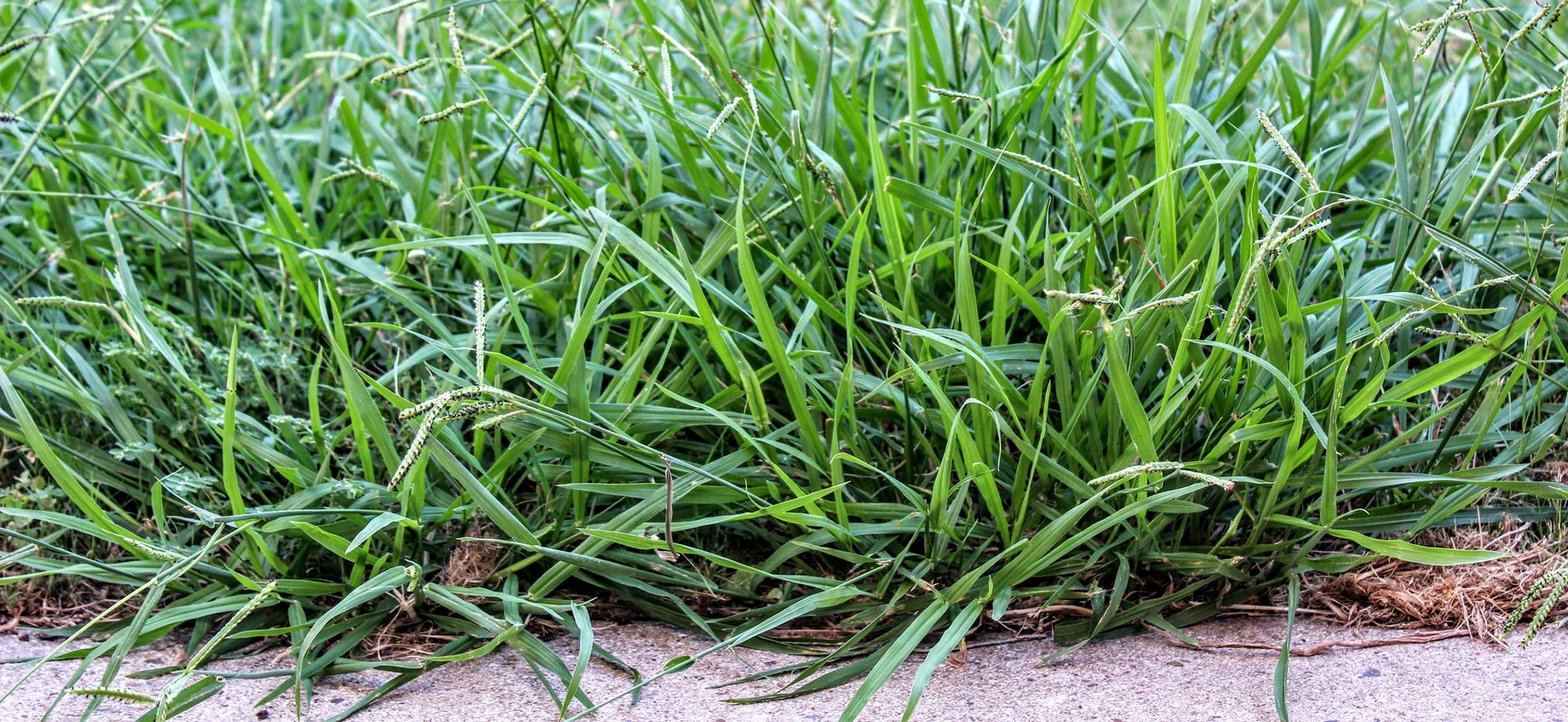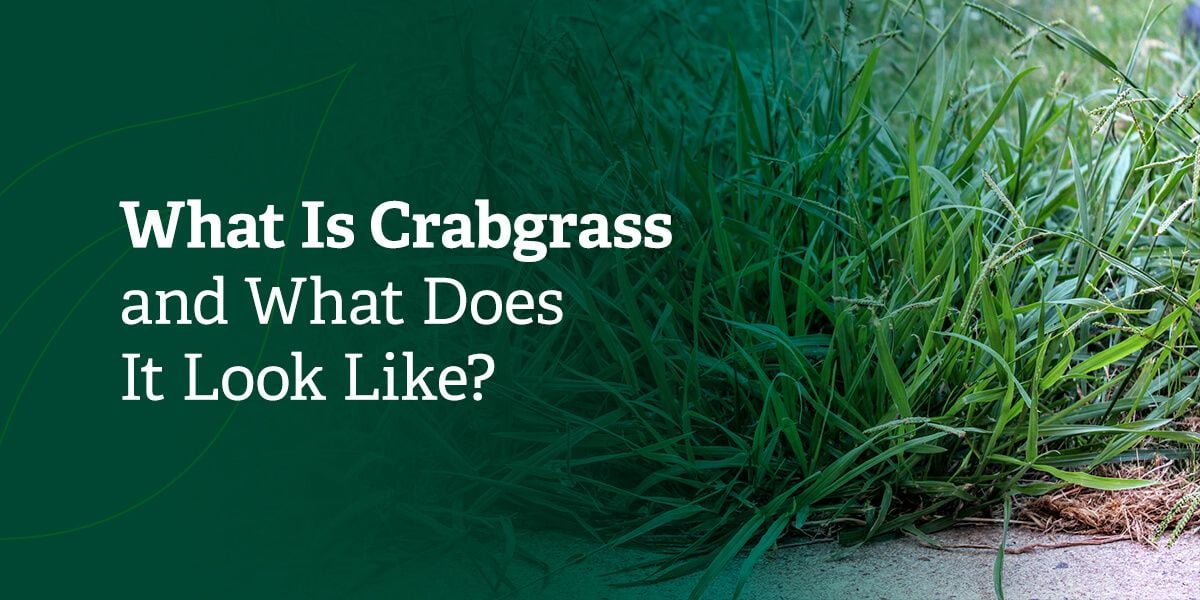

Crabgrass is a common grassweed in Maryland that germinates in the spring and appears in early summer. You’ll either find smooth or hairy crabgrass on your lawn. Since crabgrass can be challenging to remove, you’ll need to plan your prevention and treatment methods ahead of time to take care of this nuisance for good. Explore how to identify crabgrass so you can come up with your lawn maintenance strategy.
Crabgrass (scientific name: Digitaria) is an annual grassy weed that germinates in the spring and spreads rapidly. It is characterized by its low-growing habit and light green color. What does crabgrass look like? It typically has wide blades with pointed tips and a pale, almost silvery mid-vein. The blades of the plant grow in a star-shaped pattern from a central point, forming a rosette.
To identify crabgrass accurately, look for its distinctive seed heads. The seed heads resemble crab legs or fingers, which is how the weed gets its name. These seed heads develop in late summer or early fall and can produce thousands of seeds, ensuring the weed’s persistence for the next year.
Crabgrass is an annual grass weed that shows up on lawns between the spring and late summer. Your property could be vulnerable to crabgrass if you mow the lawn too short or let bare turf areas develop. This weed usually has flat, wide leaf blades and grows tall clusters of flowers. This weed can spread quickly because of its ability to produce lots of seeds each season. You might recognize crabgrass on your property by its pointed, narrow leaves and short, purplish-green stems.
There are two primary types of crabgrass — smooth and hairy. Knowing which one you have on your property can help you deal with your weeds effectively.
As the name suggests, this type of crabgrass has long, straight hairs all over its leaves and stems. Its leaves are broader than smooth crabgrass, and it grows taller. This type of crabgrass has a stout stem and a reclining growth pattern. Its flowering system has a panicle of branches with small spikes.
Even though it doesn’t have as much hair as hairy crabgrass, smooth crabgrass has hairs at the small, ear-like projections inside the leaves’ base. Its stem is slender and also has a reclining growth pattern. The weed’s flowering system has a panicle of spread-out branches, but its small spikes look similar to hairy crabgrass.
Crabgrass grows in early summer when it’s hot outside. Since it’s drought-tolerant, it can last throughout the dry summer until the ground starts to frost in the fall. In excellent growing conditions with plenty of water and nutrients, it can even look like the rest of the grass on your property. Instead of growing in the middle, the leaf blades shoot out from separate parts of the stem.
After you mow your lawn, the crabgrass will most likely grow more quickly than your lawn grass, which is when most homeowners tend to notice it. It’ll start to spread low to the ground if you mow your lawn regularly. As a result, it can bypass the mower blade and continue to grow. It also withstands areas with heavy foot traffic. After the growing season, it spreads by producing thousands of seeds.
These crabgrass identification features can help you figure out whether you have this type of weed on your lawn.
Crabgrass leaf blades are about a quarter-inch wide. As new blades develop, they grow away from the stem, and they can appear farther apart.
The most prominent feature of crabgrass is its star-like appearance as the branches get longer.
The plant creates new shoots at its center, leading to a large clump of grass. The groups of leaf blades are usually low to the ground.
Crabgrass may be the same color as your grass or slightly different, depending on what type of grass you have and whether you fertilize it.
The No. 1 most challenging weed to control in Maryland is crabgrass. Crabgrass is an annual grassy weed that has a simple life cycle in that it germinates in the spring, thrives in the summer and spreads its seed just before it dies, usually before the first frost as winter approaches. So, with such a straightforward life cycle, why is this weed so tricky to control and prevent? The reason for this has to do with temperature changes, soil moisture and timing. Follow these steps to remove crabgrass from your property.
The spring temperatures in Maryland can be a wild card for sure. We’ve had temperatures as high as 90 degrees Fahrenheit when spring approaches and as low as freezing on certain cold spring nights. The key is to pay close attention to the soil.
Using the soil temperatures will give us a road map as to when to apply your crabgrass control. It helps us eliminate the fluctuations of air temperature, which are often misleading. If you pay close attention to your soil temperature, it’s best to apply your crabgrass preventer when the soil reaches 55 degrees Fahrenheit for three to five consecutive days.
Crabgrass loves having plenty of moisture in the soil to germinate. On the other hand, since it’s resistant to drought, it can withstand changes in soil moisture more effectively than most types of lawn grass. Watering your lawn often promotes shallow root growth, which means your grass will be more vulnerable to damage during the dry, hot months. Your yard may develop patches where crabgrass can grow. It’s helpful to water your lawn thoroughly and infrequently so that your grass develops deeper roots and crowds out weeds.
After removing any crabgrass weeds you find by hand or with a shovel, it’s helpful to seed the bare spots on your lawn. Since crabgrass seeds try to overtake damaged areas where the grass is missing, you’ll want to plant grass seeds and water your yard with a garden hose or sprinkler to encourage deep root development.
Try to use the same grass seeds as the type of grass you already have on your lawn. If you’re not sure what kind of grass you have, consult your local hardware store about the grass that grows naturally in your area. Otherwise, a species that isn’t native to your local area could become invasive and take over your lawn.
When caring for your lawn, remember these tips for preventing and treating crabgrass:
The best way to treat crabgrass is through ongoing lawn care from a professional. At OrganicLawns, we have been in business for over 20 years, and we take crabgrass very seriously. We know that the most crucial part of lawn beauty is keeping crabgrass from invading our lawns. We have experience removing crabgrass from properties in Maryland for two decades and plan to make it three. Let us worry about the timing and testing and bring out a lush, thick, weed-free lawn for you. You can contact us online or call 410.536.5800 to get started on your lawn treatment.
1. How can I identify crabgrass in my lawn? You can identify crabgrass by its distinctive appearance. Look for grassy plants with blades that radiate outward from a central stem. The blades are typically wider than those of regular grass and can have a lighter green color.
2. When does crabgrass start to grow? Crabgrass thrives in warm weather and typically begins to grow in late spring when soil temperatures consistently reach around 50 to 55 degrees Fahrenheit (10 to 13 degrees Celsius).
3. What are the growth habits of crabgrass? Crabgrass has a prostrate growth habit, meaning it spreads horizontally along the ground. It can form dense patches if left untreated and can quickly compete with your desired lawn grass for resources.
4. What color is crabgrass? Crabgrass usually has a lighter green color compared to typical lawn grass. Its distinctive hue can make it stand out in a well-maintained lawn.
5. Can crabgrass produce seeds? Yes, crabgrass is known for its prolific seed production. A single plant can produce thousands of seeds, which can remain dormant in the soil for years, leading to recurrent infestations if not properly managed.
6. How can I prevent and control crabgrass in my lawn? To prevent crabgrass, maintain a healthy lawn through proper mowing, watering, and fertilization. Applying pre-emergent herbicides in early spring before crabgrass seeds germinate can also be effective. For existing crabgrass, post-emergent herbicides targeted specifically for grassy weeds can help control its growth. Regular lawn maintenance practices will contribute to a crabgrass-free lawn over time.
Remember that identifying and managing crabgrass promptly is key to maintaining a lush and weed-free lawn.